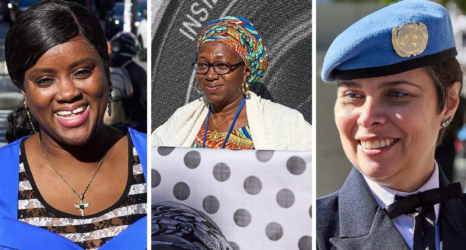Another chemical weapons attack in Syria, a caravan of Central American migrants fleeing conflict — these stories not only dominate our news, but also reinforce existing American perceptions that conflict happens abroad, not here at home.
Thanks to the Women, Peace and Security (WPS) Act, which Congress passed in October of last year, the United States is now quietly developing a new strategy to promote women’s participation in all aspects of conflict prevention, management, resolution and post-conflict relief and recovery. But it, too, will only apply to conflict beyond our borders.
If the federal government won’t turn this spotlight on ourselves, it’s time states and cities do.
This will not be the first U.S. strategy to advance women’s protection and participation in peace and security. The first was launched by Executive Order in 2011 and updated in 2016; like the third, however, both looked only overseas. And we’re not alone: Similar action plans developed by other so-called Global North states have done the same, reflecting a prevailing belief that women’s participation in conflict prevention and resolution — and the eight UN Security Council resolutions that undergird this agenda —need only apply in countries currently experiencing violent conflict. In the United States, this belief is saddled with the added weight of American exceptionalism.
But the data says otherwise.
The 2017 Global Peace Index ranks the United States as the 114th most peaceful country out of 163, using indicators ranging from homicide rates and perceived criminality to access to weapons and organized internal conflict. Drawing on metrics like the availability of adequate shelter, road deaths and safety walking alone at night, the 2017 Legatum Prosperity Index puts us at 60th in the world for safety and security—behind countries like Bahrain and Indonesia, and only four places ahead of Lebanon. Clearly, we too could use some help.
This is, in fact, what Women, Peace and Security is all about. It’s a field that struggles under its own misnomer; contrary to how it sounds, Women, Peace and Security is not about security by, of and for women—rather, it’s about drawing on the perspectives and talents of the full population to build security processes and institutions that better represent and serve the diverse populations they’re meant to. And the ever-growing body of research on this is clear: When women meaningfully participate in peace and security processes, from ceasefires and peace processes to national dialogues and constitution reform, the resulting outcomes are more effective and more durable.
The United States may not be in the throes of a peace process or constitution reform, but conflict prevention is notoriously the most overlooked, most difficult piece of security. Too often, the international community turns its attention to a conflict only after it has turned violent. Too often, we turn to women to help stabilize a country only after the killing has begun. What if a state invested its entire population in its stability and prosperity before large-scale violence broke out? Both research and practice are thin here, but according to one study on four decades of international crises, even a five percent increase in women in parliament makes a state five times less likely to use force in a crisis. Another found that across most countries in the world, the more women there are in parliament, the less likely a state is to carry out human rights abuses, including political imprisonments, torture, killings and disappearances. No matter how important and welcome the federal government’s new strategy on Women, Peace and Security may be, if it does not outline a path towards inclusive domestic security, states and cities should.
With the help of technical experts like the Global Network of Women Peacebuilders and Inclusive Security, a growing number of countries are developing local action plans to adapt the objectives of the UNSC resolutions to community security needs, identify concrete actions for implementation and coordinate with national authorities. As Bosnia and Herzegovina was revising its first national strategy, for example, its Agency for Gender Equality spearheaded a parallel process, urging mayors to conduct baseline, gendered assessment of local security; organizing trainings on the UNSC resolutions; and facilitating coordination between NGOs, local officials, social workers, police and schools. In Colombia, where a national strategy didn’t exist, local activists began advocating to mayors and public attorneys for departmental, municipal and sectoral action plans, sparking the process from the ground-up.
As these and many other case studies show, there’s no one “best” way to do this. But the United States can learn from others — so long as we’re willing to hold up the mirror to ourselves.
U.S. states and cities needn’t wait for the president to submit the new strategy to Congress. Much like they’ve stepped up to the plate on the other pressing security issues of our time, from climate change to gun regulation, they should begin convening relevant stakeholders at the municipal and state levels to take stock of the differing security needs of men and women towards strengthening community stability.
Among its other important advances, the WPS Act exhorts the United States to become a “global leader” on this issue. For America to earn that honor, we should lead by example.
This post originally appeared at the Truman Doctrine blog. Republished with author permission.





